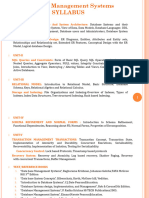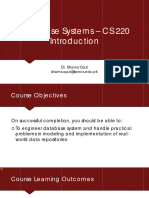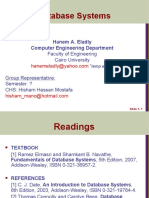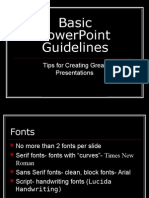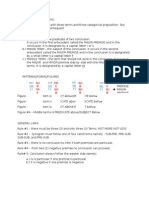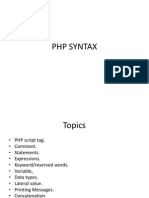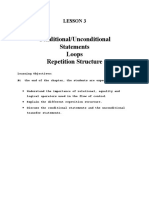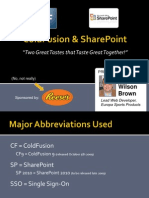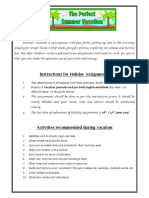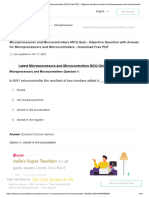IT 230 Database Management System
DBMS1
Topic Outline
Basic Terminologies
Introduction
File Systems
DBMS
Database Systems
Overview of
Database Systems
Components of
DBMS
Database Models
Types of Databases
Advantages and
Disadvantages of
Database Systems
2
Introduction
when computers were first used for business
applications, they just performed normal
record-keeping functions
these systems were called data processing
systems
Overview of
Database Systems
File Systems
prior to the emergence
of database systems,
organizational data
were kept in numerous
computer files
the information in a
folder may be the same
as the records in
computer files
Overview of
Database Systems
File Systems
files are created and
managed independently
application programs
are used to manage the
interrelationships of
files when there is a
need to link data from
different files
Overview of
Database Systems
Technology Today
Organizations today are making use of different
types of information systems which require wellorganized database systems
marketing
credit card company
airline reservation
hospitals
schools
groceries
etc.
Overview of
Database Systems
What is a Database?
A database is a collection of logically related
data that can be processed by multiple
application systems and can be shared by
multiple users.
Overview of
Database Systems
Database Management Systems
The database and its contents are managed by
a software known as a Database
Management System (DBMS).
The DBMS allows the developer or end-user
to create the structure and manipulate the data
in a database.
Overview of
Database Systems
Database System
A database system is composed of the data
stored in the database, the DBMS, the
applications, hardware and people.
software - DBMS, CASE Tools, application
software & utilities, report writers, user interface,
operating systems
people - data/database administrators, systems
developers, programmers, system administrators
Overview of
Database Systems
Scenarios
Student changes address
Retrieving a selected list of student
information
Revising reports (addition of new fields)
Strategic use of data
Overview of
Database Systems
10
Disadvantages of File Systems
Data Redundancy - waste of storage space,
multiple entries of the same data item
Data inconsistency - lack of integrity
Poor data control - synonyms & homonyms
Inflexible - requires excessive programming
Inadequate data manipulation capabilities
limited data sharing
Overview of
Database Systems
11
Advantages of Database Systems
reduced data redundancy
improved data consistency
integrated systems for preserving the
security, privacy and integrity of data
broader sharing of data
ease of application development
Overview of
Database Systems
12
Advantages of Database Systems
data independence
improved productivity for developers and
end users
reduced program maintenance
ability to use data as an organizational
resource
Overview of
Database Systems
13
Limitations of Database Systems
specialized personnel, training
cost of software acquisition
higher cost of processing routine batches of
transaction data - in terms of processing time
expensive backup and recovery procedures
user resistance to loss of data control
Overview of
Database Systems
14
Features of DBMS
cross-entity linking mechanism
data dictionary
query language
mechanisms for data access
host language interface software
data manipulation language
4GL application development software
disaster recovery & concurrency control
Data Warehousing
Overview of
Database Systems
15
Linking Mechanism
allows related entities in a database to be
linked together
no need to keep multiple copies of the same
data
Overview of
Database Systems
16
Data Dictionary
describes the structure of data and how they
are to be used
contains metadata, or data about data
also known as system catalog, which is a
system-created database that contains the
characteristics and contents of user-created
databases
Overview of
Database Systems
17
Query Language
a language that is used to retrieved selected
data from a database
used by end-users for ad-hoc queries
the Structured Query Language (SQL) is used
by most relational DBMS as a common
method of issuing database queries
Overview of
Database Systems
18
Control for Data Access
mechanisms to control access to data
protects data integrity and privacy by
controlling the actions that users can perform
on the data
Overview of
Database Systems
19
Host Language Interface
software that allows database commands to be
combined with standard programming
language commands to create applications
simplifies programming by allowing the
database to handle the data-oriented portions
of the application
Overview of
Database Systems
20
Data Manipulation Language
& 4th Generation Language
data manipulation language
enables users to access and manipulate data in a
database
4GL application development software
a visual interface software to develop applications
Form Generators and Report Generators
Overview of
Database Systems
21
Disaster Recovery & Concurrency
Control
software that provides mechanisms to recover
damaged data and control concurrent access,
or the simultaneous access by multiple users
includes maintenance of a transaction log that
contains the list of transactions and changes
made to the database
Overview of
Database Systems
22
Data Warehousing
Over Population of Data is the Achilles heel of every
DBMS
Transactions tend to grow fast and overpopulate the
database affecting its efficiency.
Over populated transactions causes difficulty in
house keeping of master files because they tend to
affect integrity constraints.
There is a need to do periodic archiving of
transaction data based on date and time stamps.
Overview of
Database Systems
23
Data Models
data models are conceptual methods of
structuring data
4 data models for implementing database
systems:
hierarchical model
network model
relational model
object-oriented model
Overview of
Database Systems
24
Model
Description
Hierarchical
relationships between data are structured as
hierarchies; uses pointer-based retrieval
Network
records are organized as collections of
arbitrary graphs; uses pointer-based
retrieval
uses a collection of tables to represent data
and relationships among data; links data by
unique columns; uses user-friendly query
language
combines data and methods/processes used
with the data; features the concept of
inheritance of properties
Relational
ObjectOriented
Overview of
Database Systems
25
Hierarchical and Network Models
both models use highly efficient pointer-based
retrieval methods
do not provide a user-friendly mechanism to
access data
relationships between data have to be determined
before they are placed into operation
inflexible to changes in the structure of a database
Overview of
Database Systems
26
Relational Model
less machine efficient than pointer-based
retrieval
can accommodate changes in the database
structure easily
Non-technical users can access the database
and retrieve selected data through query
languages
Overview of
Database Systems
27
Relational Model
increased the availability of information in
corporate databases
more flexible and easy to use
improved the conceptual efficiency of
database programming
most prevalent model in use today
Overview of
Database Systems
28
Object-Oriented Model
emerging technology
data and the methods that can be performed on
the data, are stored in objects
objects can inherit the properties of higher level
objects
have been implemented primarily in engineering
rather than business-oriented systems
Overview of
Database Systems
29
Types of Databases
Databases can also be categorized according to
the degree of centralization or decentralization
of processing that they support:
centralized
distributed
client-server
personal use
Overview of
Database Systems
30
Centralized Database Systems
all data are located at a single site and controlled by a
single computer
the central computer does all the data processing
activities, data access and retrieval, programming, and
conversion of results to the form required by the user
remote users can access the database using terminals
or data communications links
vulnerable to failure
Overview of
Database Systems
31
Client/Server Database Systems
designed to support cooperative processing
the database is stored on a server, which
handles all direct database operations
much of the processing can be moved to the
client computers (PCs connected to the
network)
Overview of
Database Systems
32
Client/Server Database Systems
reduces workload on database servers
allows higher volumes of transactions to be
handled with the servers capacity
provides greater flexibility to expand systems
gives individual users greater control over the
system
Overview of
Database Systems
33
Distributed Database Systems
a single logical database that is physically
spread across multiple computers
data are stored at the location where it is most
frequently used
minimizes the load on communications
network and gives users a sense of ownership
over the data they use most frequently
adds complexity to database processing
Overview of
Database Systems
34
Personal Database Systems
developed on a personal computer, normally
used and maintained by a single user
these databases were designed to be easy for
non-technical users; however, there is a risk of
creating islands of information where data
cannot readily be shared
Overview of
Database Systems
35







